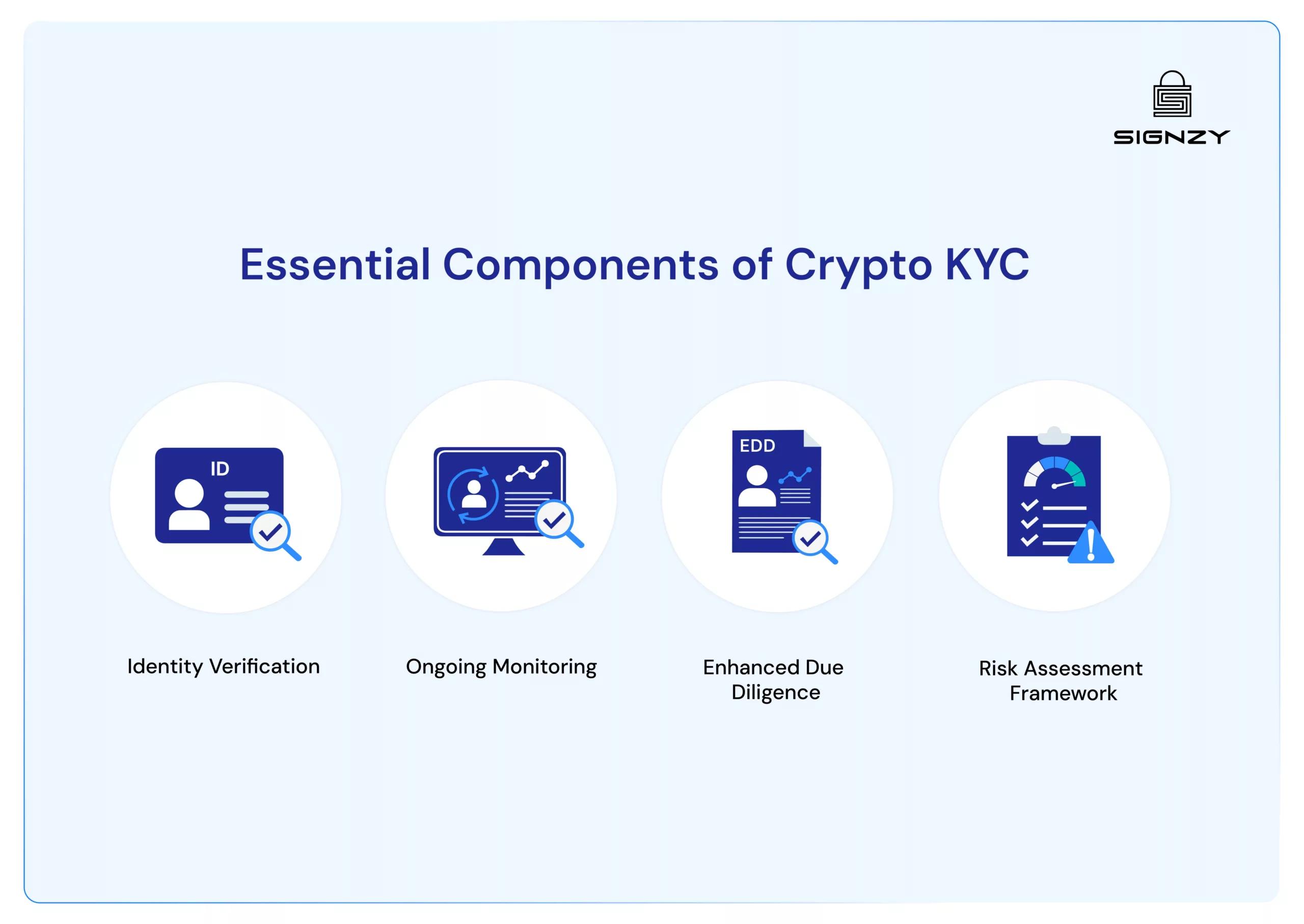KYC for Crypto Firms: Your Complete Compliance Guide for 2024
- KYC compliance is critical for crypto firms — avoiding risks of heavy fines (up to $25,000/day) and enforcement actions like the $4B Binance settlement.
- Digital KYC lowers onboarding costs by up to 90%, making customer verification faster, secure, and more user-friendly.
- A strong crypto KYC framework includes identity verification, ongoing monitoring, enhanced due diligence (EDD), and a risk-based assessment system.
- Streamlined KYC builds user trust, with platforms like Binance reporting 97% successful completions once proper KYC was introduced.
In 2023, even a giant like Binance admitted their compliance systems failed. Hackers exploited the platform, and dirty money flowed through unchecked.
This was the headline of the official DOJ (U.S. Department Of Justice) press release dated Nov. 21, 2023:
“Binance and CEO Plead Guilty to Federal Charges in $4B Resolution”
If this industry leader faced such consequences, it sends a clear message: no platform can afford to be complacent.
Knowing your customers, then, becomes the only real way to prove your platform isn’t helping any bad actors and not another Binance-type story waiting to happen.
And it’s not just bad P.R.
It’s about losing banking partnerships, getting delisted from exchanges, or even outright shutdowns by regulators who’ve had enough.
Don’t wait for regulators to come knocking. Learn how to build a compliant, efficient, and future-proof KYC system that protects your crypto business. Let’s start with nuts and bolts.
Related Solutions
What is KYC in Crypto?
Know Your Customer or Know Your Client (KYC) in crypto refers to the mandatory process of verifying customer identities, assessing their risk profiles, and monitoring their transactions to prevent fraud and financial crimes. It’s a systematic approach that helps crypto platforms comply with regulatory requirements while protecting their business and users from illicit activities.
The unique nature of cryptocurrency transactions – their irreversibility, pseudonymity, and cross-border nature – creates distinct challenges for KYC compliance.
Crypto platforms need to bridge two seemingly opposing worlds: the anonymity-centric ethos of cryptocurrency and the strict regulatory requirements of traditional finance.
The following walkthrough of essential crypto KYC components will help platforms understand and implement effective compliance measures while maintaining operational efficiency.
💡 Related Blog:
Essential Components of Crypto KYC
In the U.S., businesses must follow strict KYC procedures, and while requirements may slightly differ by state or federal authority, the essentials remain the same.
A strong crypto KYC system consists of four interconnected elements that work together to create effective protection:

1. Identity Verification
This is the core of the KYC process in crypto.
It starts by verifying key personal information such as the user’s full name, date of birth, and residential address and providing a government-issued I.D.
Many platforms also require a selfie for biometric verification to confirm that the person presenting the I.D. is actually the account holder.
2. Ongoing Monitoring
KYC doesn’t end once a user is verified. Continuous monitoring is necessary to ensure no unusual activity takes place, especially for high-risk users.
For example, transactions must be regularly checked for suspicious patterns, and users may need to be re-verified at certain thresholds. This helps prevent activities like money laundering, which is especially common in the crypto world.
3. Enhanced Due Diligence
For higher-risk users (like politically exposed persons or users making large transactions), U.S. regulations require additional scrutiny. This might include investigating the source of funds or running their names through international watchlists.
4. Risk Assessment Framework
A risk-based approach determines verification intensity and monitoring levels for different customers. Low-risk profiles require basic verification for small transactions. Medium-risk cases triggered by higher volumes or cross-border activity need enhanced checks.
High-risk profiles, marked by complex structures or unusual patterns, demand intensive due diligence and continuous monitoring. This tiered system optimizes security while maintaining efficiency.
The effectiveness of these components lies in their integration.
Consider this: Binance’s implementation of mandatory KYC resulted in only 3% user attrition – significantly lower than industry predictions. This metric challenges common assumptions about user resistance to verification procedures.
Cost of Non-Compliance
The financial impact of inadequate KYC crypto systems extends far beyond regulatory fines. Binance’s $4 billion penalty offers a sobering example, but the real costs often run deeper. Many platforms learn this lesson too late.
The immediate financial impact hits hard through regulatory fines and penalties, followed by expensive legal defense costs. Platforms often face mandatory external audits and need emergency compliance system upgrades – all while operations suffer during lengthy investigations.
The business consequences cut even deeper.
- Services face immediate suspension.
- Banking relationships – the lifeblood of any crypto platform – can terminate overnight.
- Market makers pull out
- Exchanges threaten delisting
- Credit lines freeze.
In severe cases, authorities may seize assets, effectively shutting down operations. Perhaps most damaging is the reputational fallout.
Once user trust breaks, rebuilding takes years. Small and medium-sized platforms feel these impacts most acutely. While large exchanges might absorb million-dollar fines, smaller platforms can face existential threats from even modest penalties.
Making KYC Work for Your Growth
The numbers don’t lie, but they might surprise you. When Binance finally implemented proper KYC, 97% of their users completed the process without pushback. Turns out, legitimate crypto users actually want the security and legitimacy that comes with proper verification. But here’s the catch – they want it fast, smooth, and sensible.
On top of everything, it’s important to note your KYC measures need to scale with your user’s activity.
As a one-size-fits-all approach can prove dangerous, adopting risk-based verification levels (that adjust based on transaction volumes, user behavior, and/or asset types) can be a viable solution.
Here’s an example of the approach which Binance uses:
| Tiers | Information Required | Features |
|---|---|---|
| Verified | Personal information Government-issued ID Facial Recognition | $50K Daily Fiat Deposit & Withdrawal Limits Unlimited Crypto Deposit 8M BUSD Daily Crypto Withdrawal Limit Unlimited P2P Transaction Limit Access to select Binance products, including Launchpad, OTC, Binance Card and more |
| Verified Plus | Personal information Government-issued ID Facial Recognition Proof of address | $2M Daily Fiat Deposit & Withdrawal Limits Unlimited Crypto Deposit 8M BUSD Daily Crypto Withdrawal Limit Unlimited P2P Transaction Limit Access to most Binance products, including Launchpad, OTC, Binance Card, and more |
| Enterprise | All personal information from the Verified Plus tier required Source of funds | >$2M Daily Fiat Deposit & Withdrawal Limits Unlimited Crypto Deposit Unlimited Daily Crypto Withdrawal Limit Full access |
Long story short, think of KYC like security at a concert. Nobody wants to wait in line for an hour while security checks every pocket. But everyone appreciates knowing that basic safety measures are in place. Your crypto platform needs that same balance.
Implementation Challenges and Solutions
Building an effective KYC crypto system brings real operational challenges that many crypto businesses face. The pressure to maintain a smooth user experience while meeting strict compliance standards can feel overwhelming. However, practical solutions exist.
Take the example of technology integration. Modern KYC solutions like Signzy offer APIs that smoothly connect with existing platforms, reducing development strain. The initial investment, while significant, typically yields positive returns through reduced fraud rates and higher user trust.
For teams managing these systems, clear protocols matter. This includes:
- Structured review processes for flagged accounts
- Documented escalation procedures
- Regular staff training on emerging threats
- Clear audit trails for regulatory reviews
Partner with Signzy to transform your KYC workflow. Our API marketplace offers end-to-end solutions – from identity verification to comprehensive screening APIs – helping crypto platforms go live in weeks, not months. Built for scale and compliance across 180+ countries, our solutions ensure both security and seamless user experiences.
FAQ
How long does it typically take to implement a complete KYC system for a crypto platform?
What's the minimum KYC requirement for a US-based crypto platform?
Can platforms have different KYC requirements for different transaction limits?
What immediate steps should a platform take if it detects KYC compliance gaps?
Do decentralized exchanges (DEXs) need KYC?

Agrima Dwivedi
Agrima is an Associate Product Marketer at Signzy, currently working in the B2B fintech space. She brings over two years of experience in copywriting and content writing, which laid the foundation for product marketing. Today, she leverages both creative and strategic skills to drive go-to-market efforts and build user-focused marketing strategies.


